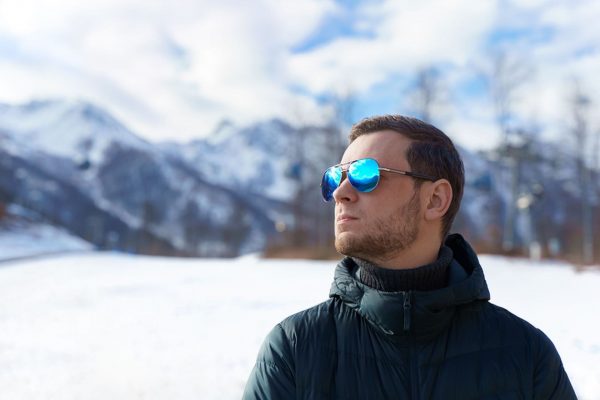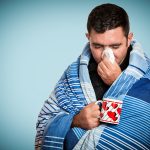Now that we’re in the fall season, temperatures are dropping around the U.S. Even down here where I live in South Florida, we’ve finally been able to say goodbye to those sweltering days of summer.
And in the upcoming months, we’ll start seeing snow flurries in the upper states.
Well, while unpacking your winter gear and analyzing what you need to purchase or update, don’t forget to add a pair of winter sunglasses to your list!
I know. You probably think of sunglasses as summer wear. But they aren’t just for sunny summer days. And they aren’t just to keep you from squinting in the sunlight.
The more important reason for sunglasses is to protect your eyes from harmful ultraviolet (UV) rays that damage your eyes. This damage is cumulative and can lead to the development of cataracts and age-related macular degeneration (AMD).
Well, guess what?
In winter, reflection off of the snow can nearly double UV strength. That’s why we so often see cases of snow blindness in snowy regions. It’s like a sunburn on your eyes caused by too much UV exposure – mostly due to UV reflection off the snow.
Additionally, higher altitudes increase UV radiation by about 2% for every 1000-foot increase in elevation. Because of the extra damage it causes, we tend to see higher rates of cataracts in high-altitude regions compared to those of lower altitude.
And beware! Some medications can increase light sensitivity of your eyes. Certain antihistamines, NSAIDs, tranquilizers, antibiotics, antidepressants and anti-diabetic drugs increase photosensitivity. If you are taking these types of meds, you need to pay extra attention to your eye health.
Ultimately, no matter who you are or where you live, exposure to bright sunlight and UV reflection from the snow or ocean can damage the retina, lead to cataracts or AMD, and worsen macular degeneration if you already have it.
So yes! It’s important to wear your sunglasses year-round.
Need Sunglasses? Bigger is Better.
Don’t just buy sunglasses that have the darkest tint. If they aren’t UV rate rated, they won’t do anything to block damaging UV rays. They’ll just keep you from squinting.
For true protections, your sunglasses absolutely need have a high UV rating. You want ones with a label that says “100% protection against both UVA and UVB” or “100% protection against UV 400.” These are the only sunglasses that will protect your eyes from the UV damage that promotes cataracts and AMD.
Try to avoid tiny sunglass trends and go big. Oversized styles will offer greater protection for all of those rays that coming in from above, below and the sides.
While they can’t fully protect you from cataracts or AMD, they can certainly cut your risk. For example, wearing sunglasses has been shown to reduce the chance of getting cataracts by nearly 60%.
It’s Not Just the UV Rays
UV rays aren’t the only thing that places wear and tear on your eyes during the winter. If you live in colder regions, dry eyes can plague you during the winter months.
Outdoors you’ve got cold, bitter winds whipping around your face. Indoors dry, hot air is blasting out of the heating vents. The air is already less humid in the winter, so all this does is aggravate your eyes.
The time you spend on your computer and other devices can leave your eyes feeling dry, gritty, blurry and irritated too.
I protect my eyes at work with a blue blocker. These are regular glasses that have the lenses that block blue light. I also keep a bottle of artificial tears on hand, because my eyes tend to get dry while staring at the screen.
I also use a heated dry eye mask. It looks a little bit like a sleep mask, and is extremely easy use. All I have to do is nuke it in the microwave for about 20 seconds, then relax with it covering my eyes.
What this does is help unblock the meibomian glands in my eyes to improve oil production which, in turn, reduces dry eye symptoms.
And that’s the key to defeating dry eyes – moisture. Drink plenty of fluids and, if possible, add a humidifier to your home. Use artificial tears if necessary.
Additionally, make sure you’re getting plenty of omega-3 fatty acids to replenish the oils that soothe and moisten your eyes. These healthy fats can go a long way in preventing dry, irritated eyes. They also help protect against AMD.
You can get your omega-3s by eating at least two servings of cold-water fish each week. Some of your best choices include wild-caught Pacific halibut, mackerel, Alaskan salmon, sardines, herring, rainbow trout and flounder.
If you aren’t a fish lover, you can always take a high-quality fish oil supplement.
For additional support against macular degeneration and cataracts I also recommend two essential eye nutrients; lutein and zeaxanthin.
Your macula is comprised almost entirely of these two carotenes. Over time, if you’re not getting enough of them, this critical part of your eye begins to thin and degenerate.
So in addition to taking getting your omega-3s, I suggest looking for an eye formula that contains at least 12 mg of lutein and 2 mg of zeaxanthin and taking it daily.
Remember, the time to start protecting your eyes is now, not after you start experiencing vision problems.
SOURCES:
Backes C, Religi A, Moccozet L, et al. Sun exposure to the eyes: predicted UV protection effectiveness of various sunglasses. J Expo Sci Environ Epidemiol 29, 753–764 (2019).
Sui GY, Liu GC, Liu GY, Gao YY, Deng Y, Wang WY, Tong SH, Wang L. Is sunlight exposure a risk factor for age-related macular degeneration? A systematic review and meta-analysis. Br J Ophthalmol. 2013 Apr;97(4):389-94.
Vanicek K, Frei T, Litynska Z and A Schmalwieser. UV-Index for the Public. European Union. 1999.
A Guide to the UV Index. United States Environmental Protection Agency. May 2004.
Sasaki H, Sakamoto Y, Schnider C, Fujita N, Hatsusaka N, Sliney DH, Sasaki K. UV-B exposure to the eye depending on solar altitude. Eye Contact Lens. 2011 Jul;37(4):191-5.
Yu JM, Yang DQ, Wang H, et al. Prevalence and risk factors of lens opacities in rural populations living at two different altitudes in China. Int J Ophthalmol. 2016;9(4):610-616.
Chen LJ, Chang YJ, Shieh CF, Yu JH, Yang MC. Relationship between practices of eye protection against solar ultraviolet radiation and cataract in a rural area. PLoS One. 2021;16(7):e0255136.
Kangari H, Eftekhari MH, Sardari S, Hashemi H, Salamzadeh J, Ghassemi-Broumand M, Khabazkhoob M. Short-term consumption of oral omega-3 and dry eye syndrome. Ophthalmology. 2013 Nov;120(11):2191-6.
Wang H, Daggy BP. The Role of Fish Oil in Inflammatory Eye Diseases. Biomed Hub. 2017 Feb 21;2(1):1-12.
Augood C, Chakravarthy U, Young I, Vioque J, de Jong PT, Bentham G, Rahu M, Seland J, Soubrane G, Tomazzoli L, Topouzis F, Vingerling JR, Fletcher AE. Oily fish consumption, dietary docosahexaenoic acid and eicosapentaenoic acid intakes, and associations with neovascular age-related macular degeneration. Am J Clin Nutr. 2008 Aug;88(2):398-406.
Krinsky NI, Landrum JT, Bone RA. Biologic mechanisms of the protective role of lutein and zeaxanthin in the eye. Annu Rev Nutr. 2003;23:171-201
AREDS2 Research Group, Chew EY, Clemons T, SanGiovanni JP, Danis R, Domalpally A, McBee W, Sperduto R, Ferris FL. The Age-Related Eye Disease Study 2 (AREDS2): study design and baseline characteristics (AREDS2 report number 1). Ophthalmology. 2012 Nov;119(11):2282-9.



